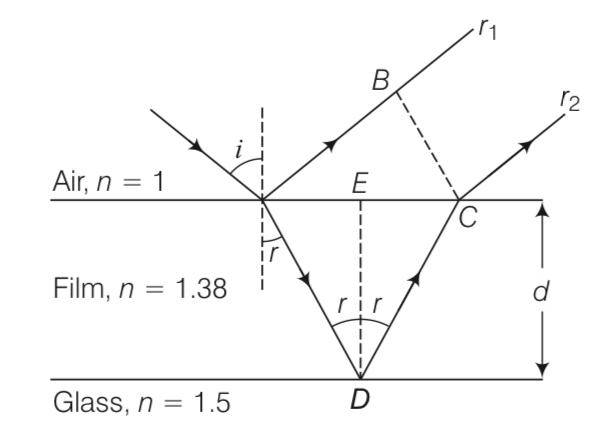To ensure almost 100% transmittivity, photographic lenses are often coated with a thin layer of dielectric material. The refractive index of this material is intermediated between that of air and glass (which makes the optical element of the lens). A typically used dielectric film is MgF2 (n=138). What should the thickness of the film be so that at the centre of the visible spectrum (5500 Å) there is maximum transmission.
To ensure almost 100% transmittivity, photographic lenses are often coated with a thin layer of dielectric material. The refractive index of this material is intermediated between that of air and glass (which makes the optical element of the lens). A typically used dielectric film is MgF2 (n=138). What should the thickness of the film be so that at the centre of the visible spectrum (5500 Å) there is maximum transmission.
-
1 Answer
-
This is a Long Answer Type Questions as classified in NCERT Exemplar
Explanation- refractive index = 1.38 refractive index = 1.5
0

Consider a ray incident at an angle i. A part of this ray is reflected from the air-film interface And apart refracted inside.
This is partly reflected at the film-glass interface and a part transmitted. A part of the
reflected ray is reflected at the film-air interface and a part transmitted as r2 parallel to r 1. Of course successive reflections and transmissions will keep on decreasing the amplitude of the wave. Hence, rays r 1 and r2 shall dominate the behaviour. If incident light is to be transmitted thro
...more
Similar Questions for you
The angle between the plane of vibration and plane of polarization is 90°.
At lower end
Tension, T? = 2g = 20 N (due to the 2 kg block)
Velocity, v? = √ (T? /μ) = √ (20/μ)
Wavelength, λ? = 6 cm
At upper end
Tension, T? = (2 kg + 6 kg)g = 8g = 80 N (due to the block and the rope)
Velocity, v? = √ (T? /μ) = √ (80/μ) = √4 * √ (20/μ) = 2v?
Since frequency (f) remains the same:
f = v? /λ? = v? /λ?
⇒ λ? = λ? * (v? /v? )
⇒ λ? = λ? * (2v? /v? ) = 2λ?
⇒ λ? = 2 * 6 cm = 12 cm
β = λD / (d? + a? sinωt)
β? - β? = λD/ (d? - a? ) - λD/ (d? + a? )
= λD [ (d? + a? ) - (d? - a? ) / (d? ² - a? ²) ]
= 2λDa? / (d? ² - a? ²)
3d = 0.6mm
D = 80cm
= 800mm
Path difference is given by
BP – Andhra Pradesh = Dx
[for Dark fringe at P]
n = 0, for first dark fringe
first dark fringe is observed on the screen directly opposite to one of the slits]
Taking an Exam? Selecting a College?
Get authentic answers from experts, students and alumni that you won't find anywhere else
Sign Up on ShikshaOn Shiksha, get access to
- 65k Colleges
- 1.2k Exams
- 678k Reviews
- 1800k Answers

